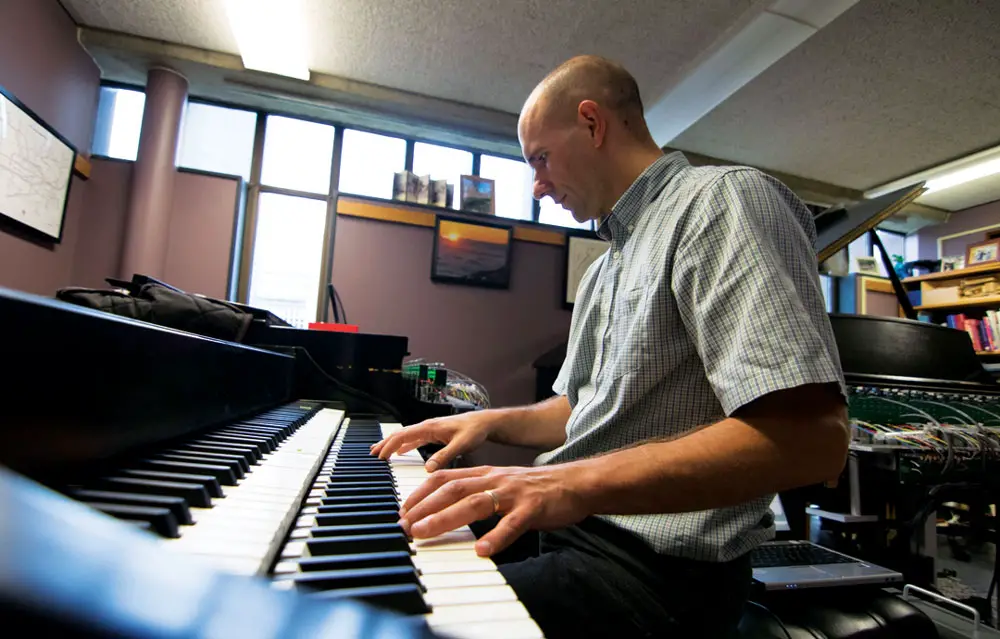Office Hours with Dr. Christopher Taylor
After discovering a century-old Steinway with a double keyboard, UW Madison professor Christopher Taylor modernized the instrument and unveiled it to the world.
By Josephine Werni, University of Minnesota
On October 28, 2016, University of Wisconsin Music professor Christopher Taylor debuted his new invention, an instrument called the Hyperpiano.
Handcrafted by Taylor himself at the Morgridge Institute Fabrication Lab, the Hyperpiano consists of two concert grands and an electronic double-keyboard console that controls both instruments. The Hyperpiano expands musical boundaries with its exquisite stereophonic sound.
I had the opportunity to talk to Taylor about the instrument, his inspiration and the tour he hopes to take sometime in the near future.
Josephine Werni: What was the inspiration for this project?
Cristopher Taylor: So, I first came to UW in 2000. At the time, I had no idea that the university actually owns an instrument that was built by Steinway in the 1920s—the only instrument they ever built that has a double keyboard.
Sometime around 2005-06, I became aware of the instrument’s existence and was really intrigued by it. I studied it, performed on it quite a bit and ultimately got to know it pretty well. However, there were certain aspects of the instrument that I wasn’t satisfied with and I wanted to find a way to improve them.

JW: What aspects of the Steinway Piano did you want to improve with the Hyperpiano?
CT: Well, because it’s got a different mechanism than a typical grand piano it feels strange under the fingers. That mechanism is very complicated—it’s quite heavy and bulky. As a pianist, you can feel the difference since you’re pushing a lot of extra weight around. I wanted to improve on that and create something that feels more like a normal instrument.
Ultimately, what I came up with was a system that takes advantage of modern electronics and actually allows you to play via remote control systems. You sort of become the master of two separate, ordinary pianos that are positioned across the room from where you are sitting and playing.
JW: How did you construct it?
CT: The majority of the manufacture took place at the Wisconsin Institute for Discovery, down in the Morgridge Institute Fabrication Laboratory. That building in general is a fabulous resource for any members of the community who have an interesting idea for something to build. They build mostly medical equipment over there.
Fortunately, they were very open-minded about having a musician come in and spend very many hours there, learning to use all the machinery. I had to pick up a lot of new skills that I never imagined I’d learn.
JW: In addition to music, you’ve also got a background in mathematics and computer science—did this play a big role in the inspiration for this project and your ability to execute it?
CT: Indeed. My undergraduate degree was in mathematics and for many years when I was young, I kind of sat on the fence about what I was going to do with my career. I’ve always maintained a pretty diverse array of interests, so this project ended up being a logical continuation of that pattern. I was able to take advantage of the various skills I’ve cultivated over the years, particularly computer programming, which has been my main hobby for a long time.
JW: In the future, do you think that there will be music composed specifically for the Hyperpiano’s capabilities?
CT: Yeah, that’s my ambition. I’ve been in conversation with a few composers about it. Hopefully, in the next few years, I’ll have some new pieces that I can perform on it.
JW: Other than creating music for it, do you have any other plans for the Hyperpiano in the future, or possibly for an entirely new project altogether?
CT: I mean, there are still technical aspects of it that need refinement and it’s going to be a long process to perfect it. But, I’ve invested a lot in it and I’m going to keep working on it and get it the best it can possibly be. I’m still learning all the time about different ways to make it work.
I do hope to take it around the country like I did with the old instrument. As for a new project, it will definitely be a couple of years before I subject myself to that. I’m sure I’ll eventually get the itch to do something else—check back in five years and I’ll probably have something cooking.
To learn more: Check out this Double Manual Piano Documentary.











